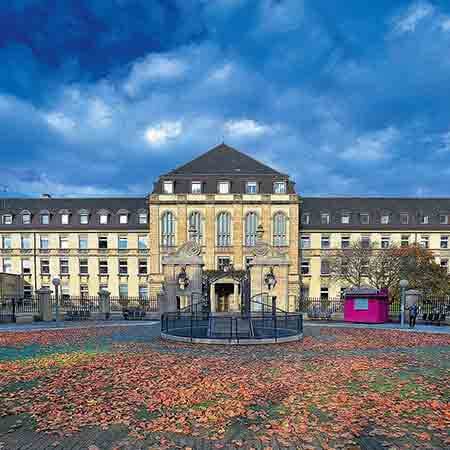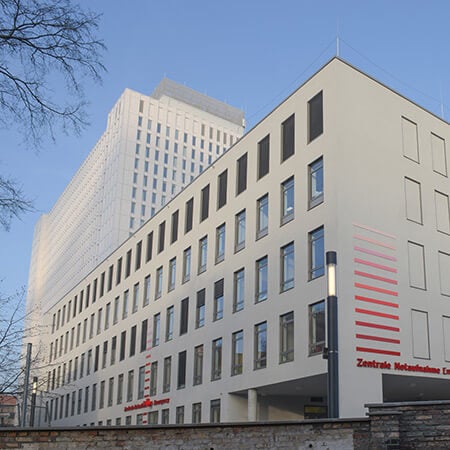Erythroid myeloma (multiple myeloma)
Due to the difficulties associated with the organization of treatment in Turkey, Switzerland, South Korea and India, we are not currently processing requests to these regions.
If you are interested in treatment in Germany, please leave a request and our specialists will contact you as soon as possible.
Multiple myeloma is an oncological disease of the hemopoietic system, which is characterized by the occurrence of tumors from the bone marrow plasma cells. The incidence in different countries varies from 1 to 4 cases per 100.000 of population per year. Men suffer more often than women. Multiple myeloma mainly affects elderly people. 97% of patients are over the age of 40. The disease almost never occurs, except for a few exceptions, among people under 30 years of age.
The Booking Health portal presents 53 German clinics specializing in erythroid myeloma (multiple myeloma) treatment
Show all clinics
Multiple myeloma – Diagnostics
The clinical picture, changes in blood (hemoglobin low level, increased calcium level) and urine (proteinuria) allow to suspect the disease.
The further instrumental and laboratory examinations are performed to verify the diagnosis:
- Sternal puncture is the main method of the diagnostics. The bone marrow is aspirated from the sternum. The number of plasma cells is higher than 15%. Younger the cells that form the basis of the tumor are, worse the prognosis is.
- Radiography helps to detect osteoporosis and the areas of osteolysis. At the first stage of multiple myeloma the changes on the radiograph may be absent.
- Electrophoregram of the serum proteins is performed to determine paraprotein with the help of the immunoelectrophoresis. This method allows to establish the size of the tumor mass and determine the stage of the disease.
Best clinics for the multiple myeloma diagnostics in Germany:
Multiple myeloma – Treatment
Multiple myeloma can be treated with help of surgery, as well as with the help of conservative therapy. Conservative therapy is used much more often.
- Chemotherapy is the main treatment method. The medications which block the tumor mass growth are prescribed. Chemotherapy helps to significantly increase the life expectancy of the patients. New drugs constantly appear and their different combinations are used for the prognosis improvement.
- Stem cells transplantation. They may be taken from the bone marrow (bone marrow transplantation), or peripheral blood. There are allotransplantation (from a donor) and autologous transplantation (own stem cells). The patient receives intensive chemotherapy with high doses of drugs and radiation therapy in order to destroy the bone marrow cells before the surgery. Only allotransplantation can give a chance for a complete recovery, while the autologous transplantation is just a temporary solution. It should be added that allotransplantation is accompanied by the certain obstacles (high price, high post-surgery risks, and difficulties in finding a suitable donor).
- Radiation therapy is used just as a palliative treatment. It allows to reduce the symptoms of the disease and relieves the rest of the patient's life.
- Symptomatic therapy. Simultaneously with the main treatment a patient receives painkillers, drugs to fight against anemia and manifestations of renal failure, and therapy for support of the functions of other internal organs.
Best clinics for the multiple myeloma treatment in Germany:


Multiple myeloma – Rehabilitation
Most patients require rehabilitation after the treatment of complex oncological diseases. It includes the following aspects:
- Prevention of complications that may occur as a result of treatment. It can be pneumonia, lymphostasis, thromboembolic or infectious complications.
- Restoration of general health. The elimination of the consequences after surgeries and chemotherapy is carried out. The functions of internal organs are restored with the help of various medical and rehabilitation measures.
- Restoration of occupation. A person must not just stay alive. He must have physical and intellectual capabilities, which are sufficient for employment.
- Psychological support. First of all, it is required for patients, whose occupational performance was harmed because of the disease. Patients with deterioration of appearance also will benefit from psychological help.
- Restoration of appearance. If necessary, you can use surgical and other methods in Germany to restore appearance defects caused by cancer. For example, to carry out the reconstruction of the breast.
- Social and domestic rehabilitation. A person with reduced workability is trained to act in the society and perform everyday tasks in new conditions.
In German clinics, rehabilitation is carried out in a comprehensive manner. The patients are provided with qualitative care here. Doctors' monitoring and conservative treatment allow to avoid complications, which usually happen after treatment of oncological diseases. Psychotherapy, physiotherapy and physical therapy are actively used in Germany.
Specialists in different medical spheres take part in the rehabilitation process. These are massage therapists, speech therapists, specialists in physiotherapy exercises, physiotherapists. Social and occupational therapy is carried out, as well. If necessary, people are taught how to eat properly, take care of a colostomy or urostomy, etc.
In Germany, rehabilitation is carried out with the maximum level of comfort for the patient. A person feels the results quite quickly and it improves his motivation and promotes further recovery.
Best clinics for oncological rehabilitation in Germany:
Author:
The article was edited by medical expert, board certified Dr. Nadezhda Ivanisova. For the treatment of the conditions referred to in the article you must consult a doctor; the information in the article is not intended for self-medication!
Sources:
European Society for Medical Oncology
The cost of services includes
Here you can find the cost of treatment for this disease at the German University Hospitals. Leave a request and we will provide a free consultation with a doctor and will start organizing the whole treatment process.
The program includes the following:
- Issuing of an invitation for getting a visa for treatment as quick as possible
- Fixing an appointment at a time convenient for you
- Preliminary organization of a comprehensive examination and discussion of the forthcoming treatment plan
- Arranging transfer from the airport to the hospital and back to the airport
- Provision of interpreting services and services of a personal medical coordinator
- If necessary, assistance in the organization of further surgical treatment
- Provision of a medical insurance against treatment complications covering up to 200,000 euro
- Preparation and translation of medical records and recommendations from the hospital
- Assistance in the subsequent communication with your attending physician, including consultations on repeated X-ray images through the unique medical document management system E-doc




